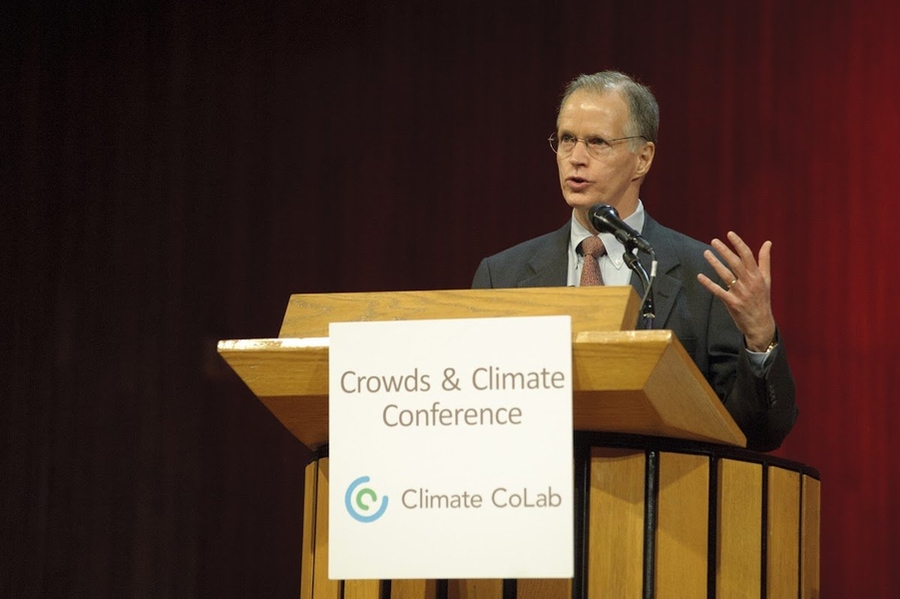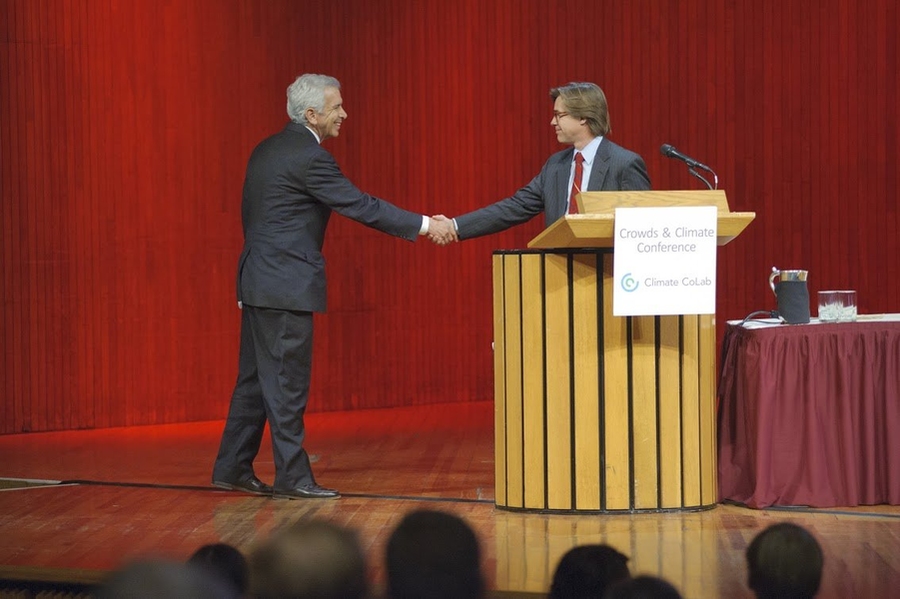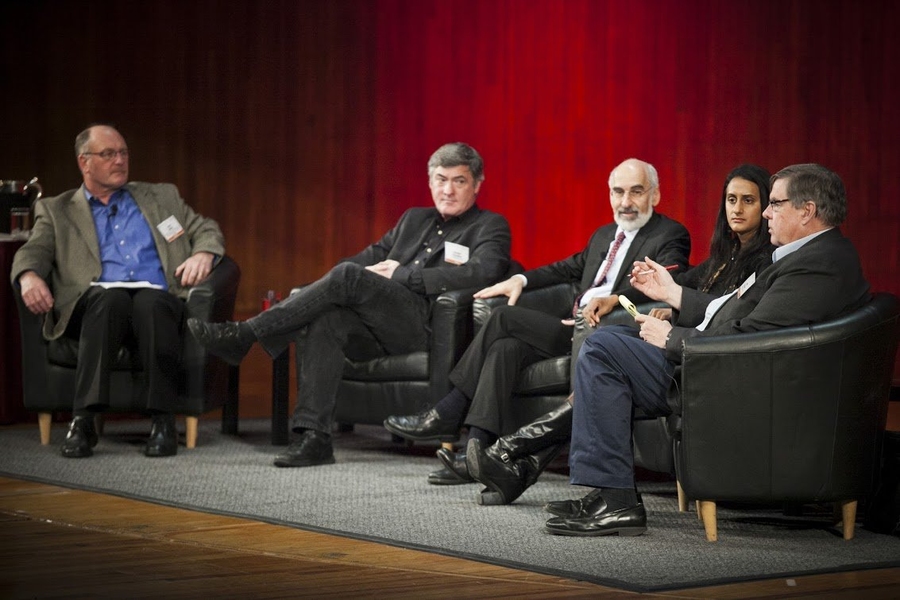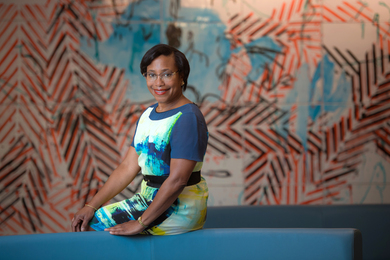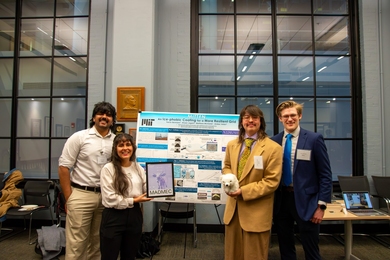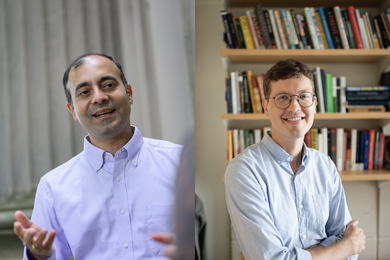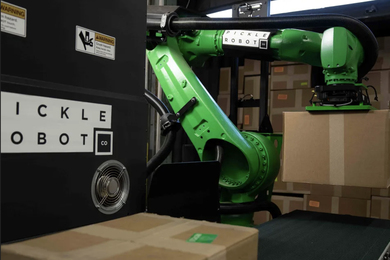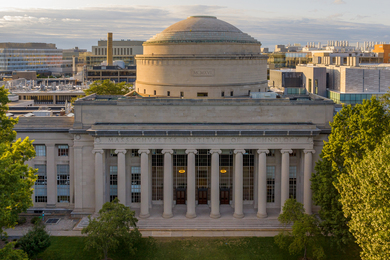As international climate negotiators meet this month for the 19th meeting of the UN Conference of Parties (COP19), there’s an increasing realization that top-down efforts to confront climate change aren’t working — or at least, they’re not working quickly enough. Are there ways that large groups of people — even a global community— could work together to take action now? That was the focus of an MIT climate conference last week, titled “Crowds and Climate.”
“We know how to make real progress on climate change, what we must create is the political will to achieve it. Creating that will requires all of us to engage. It can’t be a top-down process,” said Environmental Defense Fund President Fred Krupp, who gave a keynote speech on Nov. 6. “The arch of the moral universe may bend toward justice, but the line on the graph of global emissions won’t bend until we make it do so.”
To help bend that line downward and develop creative innovative ideas to take action on climate change, the conference explored the role new technology-enabled approaches — such as crowdsourcing, social media, and big data — could play. It was sponsored by the MIT Center for Collective Intelligence’s Climate CoLab, and co-sponsored by the MIT Energy Initiative, MIT Joint Program on the Science and Policy of Global Change, and MIT Sloan Sustainability.
The conference underscored the aim of the Climate CoLab itself, which looks to shift public engagement on climate change from one of just science or ideology to a much broader and more inclusive participation. It does so by crowdsourcing, through contests, citizen-generated ideas on a range of topics relevant to climate change. The community has been doubling or tripling with each annual contest, and there are now more than 10,500 registered members. The community’s rapid growth shows that there are many smart and creative people around the globe ready to engage in these issues.
“By bringing together experts, policy makers, business people, and many others, we hope the Climate CoLab can help plan — and gain support for — better climate actions than anything we humans would otherwise have done,” said Prof. Thomas Malone, director of the MIT Center for Collective Intelligence and principal investigator for the Climate CoLab,. “Even if we don’t achieve this, engaging crowds in the process will likely increase support for and awareness of the solutions.”
In addition to honoring the 28 winners of this year’s contests, and awarding a Grand Prize winner, the conference gathered a large group of smart and creative people to discuss these issues. The two-day event attracted more than 800 in-person and online attendees.
Organizing crowds
Using a bottom-up approach to confront climate change first requires building a base, according to Marshall Ganz, senior lecturer in public policy at Harvard University. “What drives movements is not branding, but relationships; … building constituencies at the base,” he said.
To build a base, the crowd needs to be able to relate, said Andrew Hoffman, Holcim (U.S.) Professor of Sustainable Enterprise at the University of Michigan. “As long as it’s this idea in the ivory tower presented by a scientist using a language people don’t understand, they will still question whether they believe that theory or not,” Hoffman said.
Instead, climate change should be tied to things that resonate with people; for example, the rising cost of insurance. “Talk about the ski season to skiers, or about habitat changes to hunters,” said Kate Gordon, vice president at Next Generation.
Inserting unexpected validators also helps. Bob Inglis, a former Republican congressman from South Carolina and the founder of the Energy and Enterprise Initiative at George Mason University, pointed out that business people can act as good validators. “When smart money starts moving that way, that has a real educational impact on people.”
Ganz and Hoffman both noted that outside factors — such as events — can shift the conversation toward a desired social change. Hoffman used Hurricane Katrina and Superstorm Sandy as examples.
“Sandy created a fundamental change in how we think about climate change, Katrina did not,” Hoffman said. “Katrina hit a minority population that was fundamentally disconnected and had no spokespeople. Sandy hit an affluent population that was politically connected and had Michael Bloomberg.”
Sergej Mahnovski, the director of New York City’s Long Term Planning and Sustainability, backed up this idea that one event can spur change. He noted that New York City’s sustainability planning was going slowly until Sandy hit and brought a sense of urgency amongst the people of New York, and thus, their leaders.
While it may take time to create a crowd, David Yarnold, president of the National Audubon Society, points out that there is a precedence of social movements creating environmental change. The first Earth Day was one of the largest grassroots demonstrations in the nation’s history, and it was followed by the creation of the U.S. Environmental Protection Agency and the passage of the Clean Air Act.
“There is a precedence in the U.S. in terms of environmental and conservation action that demonstrate that when the American people decide that something is a priority, they’ll actually do it,” Yarnold said.
Tools for change
In the age of Twitter and iPads, technological advances can be used to help create a community and expand their impact. This is as true in the context of climate change as it is in almost any global challenge today.
“In the past, changes had figureheads,” said Practically Green CEO Susan Hunt Stevens. “With Arab Spring, there were some players, but social media ended up being the figurehead… it can be used to bring visibility to the change and connect people.”
Other nontraditional forms of media have aided the climate cause as well.
Pace University senior fellow and New York Times Dot Earth blogger Andrew Revkin gave many examples — including a high school science teacher who posts simple explanatory videos on YouTube for all to watch.
“Just building the capacity for the exchange of ideas across boundaries is really important and I think it can lead to some surprising results,” Revkin said.
Crowds can also help compile big data and turn it into useful information, said Bina Venkataraman, President Obama’s senior advisor on climate change innovation. In addition, she noted crowds play an important role in validating what data is useful and what is not.
But while crowds can validate data, we also need ways to validate crowds, according to MIT Sloan School of Management Professor John Sterman. “If you just have the crowd and you don’t have the ability to test the ideas, nothing’s going to work… learning’s much slower.”
Sterman directs Climate Interactive, an organization that has created a simple climate model that anyone can run on their laptops. He has embedded his model into the Climate CoLab contest so that the crowds’ ideas can be tested instantly using the models to see which ideas work best.
“Our goal is to test whether that actually amplifies the rate at which we can come up with excellent solutions,” Sterman said. “So you have this combination of the talents and wisdom of the crowds with the testing platform that’s enabled by the simulation models that you can run instantly.”
Sterman concluded that the Climate CoLab’s work, and conferences like this one, is needed to further the climate debate and help bring about solutions.
“Climate science needs to continue. But it’s not the bottleneck to progress,” Sterman said. “We need more research, and I think the Climate CoLab enables this research on… how that turns a crowd into a movement and into organizations that can make a difference.”
Anyone from around the world is invited to submit ideas to the Climate CoLab, which is now receiving proposals. Keeping with the crowdsourcing orientation, community members are invited to suggest contests they think can make a difference at http://climatecolab.org.
“We know how to make real progress on climate change, what we must create is the political will to achieve it. Creating that will requires all of us to engage. It can’t be a top-down process,” said Environmental Defense Fund President Fred Krupp, who gave a keynote speech on Nov. 6. “The arch of the moral universe may bend toward justice, but the line on the graph of global emissions won’t bend until we make it do so.”
To help bend that line downward and develop creative innovative ideas to take action on climate change, the conference explored the role new technology-enabled approaches — such as crowdsourcing, social media, and big data — could play. It was sponsored by the MIT Center for Collective Intelligence’s Climate CoLab, and co-sponsored by the MIT Energy Initiative, MIT Joint Program on the Science and Policy of Global Change, and MIT Sloan Sustainability.
The conference underscored the aim of the Climate CoLab itself, which looks to shift public engagement on climate change from one of just science or ideology to a much broader and more inclusive participation. It does so by crowdsourcing, through contests, citizen-generated ideas on a range of topics relevant to climate change. The community has been doubling or tripling with each annual contest, and there are now more than 10,500 registered members. The community’s rapid growth shows that there are many smart and creative people around the globe ready to engage in these issues.
“By bringing together experts, policy makers, business people, and many others, we hope the Climate CoLab can help plan — and gain support for — better climate actions than anything we humans would otherwise have done,” said Prof. Thomas Malone, director of the MIT Center for Collective Intelligence and principal investigator for the Climate CoLab,. “Even if we don’t achieve this, engaging crowds in the process will likely increase support for and awareness of the solutions.”
In addition to honoring the 28 winners of this year’s contests, and awarding a Grand Prize winner, the conference gathered a large group of smart and creative people to discuss these issues. The two-day event attracted more than 800 in-person and online attendees.
Organizing crowds
Using a bottom-up approach to confront climate change first requires building a base, according to Marshall Ganz, senior lecturer in public policy at Harvard University. “What drives movements is not branding, but relationships; … building constituencies at the base,” he said.
To build a base, the crowd needs to be able to relate, said Andrew Hoffman, Holcim (U.S.) Professor of Sustainable Enterprise at the University of Michigan. “As long as it’s this idea in the ivory tower presented by a scientist using a language people don’t understand, they will still question whether they believe that theory or not,” Hoffman said.
Instead, climate change should be tied to things that resonate with people; for example, the rising cost of insurance. “Talk about the ski season to skiers, or about habitat changes to hunters,” said Kate Gordon, vice president at Next Generation.
Inserting unexpected validators also helps. Bob Inglis, a former Republican congressman from South Carolina and the founder of the Energy and Enterprise Initiative at George Mason University, pointed out that business people can act as good validators. “When smart money starts moving that way, that has a real educational impact on people.”
Ganz and Hoffman both noted that outside factors — such as events — can shift the conversation toward a desired social change. Hoffman used Hurricane Katrina and Superstorm Sandy as examples.
“Sandy created a fundamental change in how we think about climate change, Katrina did not,” Hoffman said. “Katrina hit a minority population that was fundamentally disconnected and had no spokespeople. Sandy hit an affluent population that was politically connected and had Michael Bloomberg.”
Sergej Mahnovski, the director of New York City’s Long Term Planning and Sustainability, backed up this idea that one event can spur change. He noted that New York City’s sustainability planning was going slowly until Sandy hit and brought a sense of urgency amongst the people of New York, and thus, their leaders.
While it may take time to create a crowd, David Yarnold, president of the National Audubon Society, points out that there is a precedence of social movements creating environmental change. The first Earth Day was one of the largest grassroots demonstrations in the nation’s history, and it was followed by the creation of the U.S. Environmental Protection Agency and the passage of the Clean Air Act.
“There is a precedence in the U.S. in terms of environmental and conservation action that demonstrate that when the American people decide that something is a priority, they’ll actually do it,” Yarnold said.
Tools for change
In the age of Twitter and iPads, technological advances can be used to help create a community and expand their impact. This is as true in the context of climate change as it is in almost any global challenge today.
“In the past, changes had figureheads,” said Practically Green CEO Susan Hunt Stevens. “With Arab Spring, there were some players, but social media ended up being the figurehead… it can be used to bring visibility to the change and connect people.”
Other nontraditional forms of media have aided the climate cause as well.
Pace University senior fellow and New York Times Dot Earth blogger Andrew Revkin gave many examples — including a high school science teacher who posts simple explanatory videos on YouTube for all to watch.
“Just building the capacity for the exchange of ideas across boundaries is really important and I think it can lead to some surprising results,” Revkin said.
Crowds can also help compile big data and turn it into useful information, said Bina Venkataraman, President Obama’s senior advisor on climate change innovation. In addition, she noted crowds play an important role in validating what data is useful and what is not.
But while crowds can validate data, we also need ways to validate crowds, according to MIT Sloan School of Management Professor John Sterman. “If you just have the crowd and you don’t have the ability to test the ideas, nothing’s going to work… learning’s much slower.”
Sterman directs Climate Interactive, an organization that has created a simple climate model that anyone can run on their laptops. He has embedded his model into the Climate CoLab contest so that the crowds’ ideas can be tested instantly using the models to see which ideas work best.
“Our goal is to test whether that actually amplifies the rate at which we can come up with excellent solutions,” Sterman said. “So you have this combination of the talents and wisdom of the crowds with the testing platform that’s enabled by the simulation models that you can run instantly.”
Sterman concluded that the Climate CoLab’s work, and conferences like this one, is needed to further the climate debate and help bring about solutions.
“Climate science needs to continue. But it’s not the bottleneck to progress,” Sterman said. “We need more research, and I think the Climate CoLab enables this research on… how that turns a crowd into a movement and into organizations that can make a difference.”
Anyone from around the world is invited to submit ideas to the Climate CoLab, which is now receiving proposals. Keeping with the crowdsourcing orientation, community members are invited to suggest contests they think can make a difference at http://climatecolab.org.
- Watch video from the conference: http://www.climatecolab.org/conference2013/virtually
